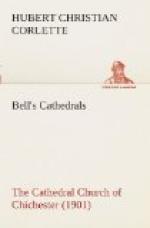The #West Porch# is a comparatively simple structure. It rises from the ground with a deep weathered base. At the top of the walls is a plain weathered coping, which overhangs about one inch. The simple, but extremely well designed, buttresses at the north and south angles add much interest to it as a composition artistically and as a study in structure. The small, straight buttresses on the west are only weathered once, and this at the top; but those on the north and south sides are different. There is a broad central buttress weathered twice from the base to its top, and in the angle on either side of it are what appear to be two lower, smaller buttresses, with one weathering slope. The probability is that there was only a small buttress here at first, and that the larger one on either side was added by being built over the shallower, broader, and shorter one.
[Illustration: WALL-ARCADE IN THE WEST PORCH. S.B. Bolas & Co., photo.]
These buttresses have been placed here in order to counteract the thrust of the large, deeply-set covering arch over the entrance to the porch. This arch is of interest, as it has but a slight label; and then the outside angle of the soffit only is moulded, the rest being recessed both at the jambs and in the arch for about two feet, with no mouldings at all. Then comes a delicately moulded arch in two orders, immediately beneath which are the coupled arches which give entrance to the interior, vaulted apartment. These two arches, the central and side shafts on which they rest, as well as the tympanum between them, are restorations.
The vault over the interior of the porch is carried on moulded diagonal ribs. On the north, south, and west are wall ribs as well, to carry the chalk filling between them. The insertion of two later monuments, now much dilapidated, involved the destruction of much of the beautiful wall arcades. These were of three complete divisions on each wall, and have cusped heads. The upper part, below the finishing horizontal string-course, is composed of two full and two half quatrefoils. The work in each arcade is recessed quite seven inches from the face of the general walling above; and the multiplied detail in the mouldings is finely studied. Opposite the entrance is the west doorway into the nave. The deep arch over this is seriously cracked in several places, though it has already been much restored. It has an outer label, which indicates that when it was built in there was then no porch to protect it. The three orders, or main groups, of mouldings do not run down on to the capitals, but finish by dying on to a plain piece of stonework of circular form set immediately upon the capitals. The Purbeck marble capitals themselves are rather large and heavily moulded, and the shafts under them are sandstone restorations of recent date. The west door and the woodwork about it is a poor specimen of modern ingenuity.
The #South Side# of the church introduces many interesting varieties of work. These may well be followed in the course of this description from the west to the east end.




